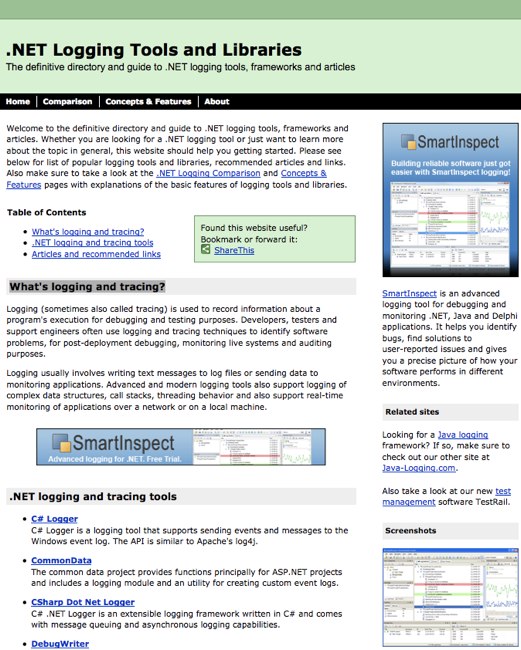So you’ve tried endlessly tweaking your AdWords, starting a blog and even begun Twittering this year, and you’re still on the second or worse page of Google results for the keywords that matter most. How are you going to change this for 2010? Consider creating and maintaining a microsite.
A microsite (at least for the length of this post) isn’t a brochure-like static page about your product, or a shady way to generate inbound links. In fact, it only just touches your product and does everyone in your market a valuable service. A microsite is a way to monetize for reputation/attention a chunk of all that expertise you’ve built up, in the same way your software monetizes that expertise for money.
How would you like to be able to say this?
“Just a week after launching the sites they got to the first page of Google results for the main keywords… the .NET microsite ranks #1 for .NET logging as of today“.
That’s Dennis Gurock of Gurock Software explaining in this post just what results he got by creating 2 microsites. Here’s Dennis’ .NET Logging site:

It’s simple, useful to the people who could be interested in his software, informative rather than marketing. In fact, it only lightly mentions his product SmartInspect. What’s more, it’s not aimed at experts, it’s aimed at the much larger number of non-experts, beginners, newbies out there who’ll appreciate a “take them by the hand and show them the ropes” approach to this developer topic. And by definition, newbies always outnumber experts in whatever problem domain your product or service addresses.
Here’s some of the finer points of building a successful microsite, reverse-engineered from .NET Logging:
- The key term you want to dominate must be in the URL.
This is the magic bullet of Google pagerank. If you’re planned microsite can’t get the same strength URL as Dennis did for the term “.NET logging” as http://www.dotnetlogging.com/, pick another topic. - SEO matters.
Just doing the simple SEO things you already should know about makes a big difference when building a microsite. Not sure what those are nowadays? Get your hands on a copy of Dharmesh Shah’s “Inbound Marketing” that’s now a bestseller. - Context your product, do not market it.
Since this microsite touches on an area your product deals with, include it amoung the other solutions out there, but don’t market it. Marketing kills credibility within the context of a microsite. Don’t. Do. It. - Your supported opinion, personal experience and professional judgment are what’s on offer here.
Include as appropriate your (supported with at least one reason) opinion, personal experience and professional judgment. This is not about being ‘objective’, it’s about offering your point of view on information you’ve researched and collected as a way of giving back to your market/community. - Put some effort into it, and update it regularly.
People can tell whether you just threw together something or you’ve taken the time to do it right. Do it right – or outsource the basic research to someone competent and then add your experience in. Also, put in place a procedure/layout so you can update your microsite easily on an ongoing basis.
For example, a well-thought out submission form works well. You want to do this for two very good reasons: people are going to start sending you feedback/resources to include and you will find it far easier to deal with these prospective customers well by having a process in place. Second, Google is changing how people will use it in 2010 to find your software: recent updates will matter much more. (see this post for details.)
If you want a checklist to work from as you build your microsite, here’s one you can have for free that I created for my startup. If you want to amend it, just get a free Checkvist account and copy it to your account.
Finally, I asked Dennis now that it’s over six months, Has it been worth the effort?
“Yes, definitely. It actually took us only 1-2 days to create both our microsites, but we have been benefiting from the sites ever since (mainly due to great search engine rankings and from people linking to the sites). We have been receiving a steady amount of visitors that click through the microsites to our main product site”.





